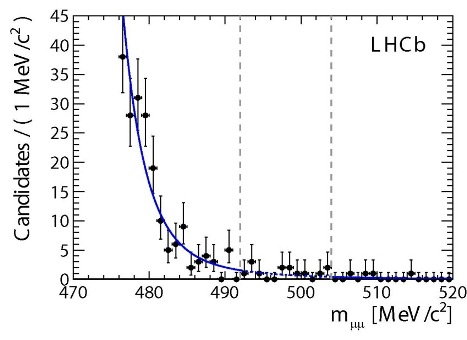[ Branching ratio K0S →μμ < 9×10-9 at 90% CL ]
Having previously set the world’s most restrictive limits on the dimuon decays of D0, B0 and B0s mesons, LHCb physicists have turned their attention to the search for similar decays of another member of the particle zoo, the K0S meson. Using the 2011 data sample, LHCb has set a limit on the branching ratio B(K0S→μ+μ–) to be less than 9×10-9, a factor of 30 improvement over the previous most restrictive limit measured in 1973. [For experts: the limit is at 90% confidence level.] While several techniques used were common with the search for B0s→μ+μ– (see news items of 8 April and 22 July 2011 and 5 March 2012 for more details), the challenge of this measurement lies in the specificity of kaon decays, which are very different from B decays for which LHCb detector was optimized.
The image below shows the invariant mass distribution of selected μ+μ– pairs, candidates for K0S decay. The dashed lines indicate the signal region around the K0S mass, where no significant signal is seen.
click the image for higher resolution
K meson decays into pairs of muons played a very important role in the history of particle physics. There are two types of K mesons: the short-lived, K0S (“K-short”) and the long-lived, K0L (“K-long”). The results of branching ratio measurements of the K-long decay into muon pairs in the early 1970s disagreed strongly with the predictions of particle physics theory based on existence of three quarks u, d and s. The calculated branching ratios were of the order of 10-4 while the experimental limits were about 4 orders of magnitude lower. In order to solve this problem Glashow, Iliopoulos and Maiani proposed the existence of an additional quark, called a charm quark – a 1970s version of a new physics model. In the mechanism they proposed (GIM mechanism) a destructive virtual contribution of this new quark reduced very strongly the K-long decay rate into muon pairs. The discovery of the J/ψ state in November 1974 gave the first evidence for the existence of charm quark and at the same time confirmation of the GIM mechanism.
40 years later LHCb physicists are searching for K-short decays into muon pairs, again on the look-out for new physics. The branching ratio is calculated to be 5×10-12 within the framework of the Standard Model of particle physics with 6 quarks. Although the new limit 9×10-9 is still three orders of magnitude above the prediction, it starts to approach the level where new physics effects might begin to appear. Moreover, the data collected by LHCb in 2012 already exceed the sample from 2011 and by the end of the year the total dataset should have more than tripled.
Read more in the CERN Courier article, the CERN Quantum Diaries and LHCb publication.

